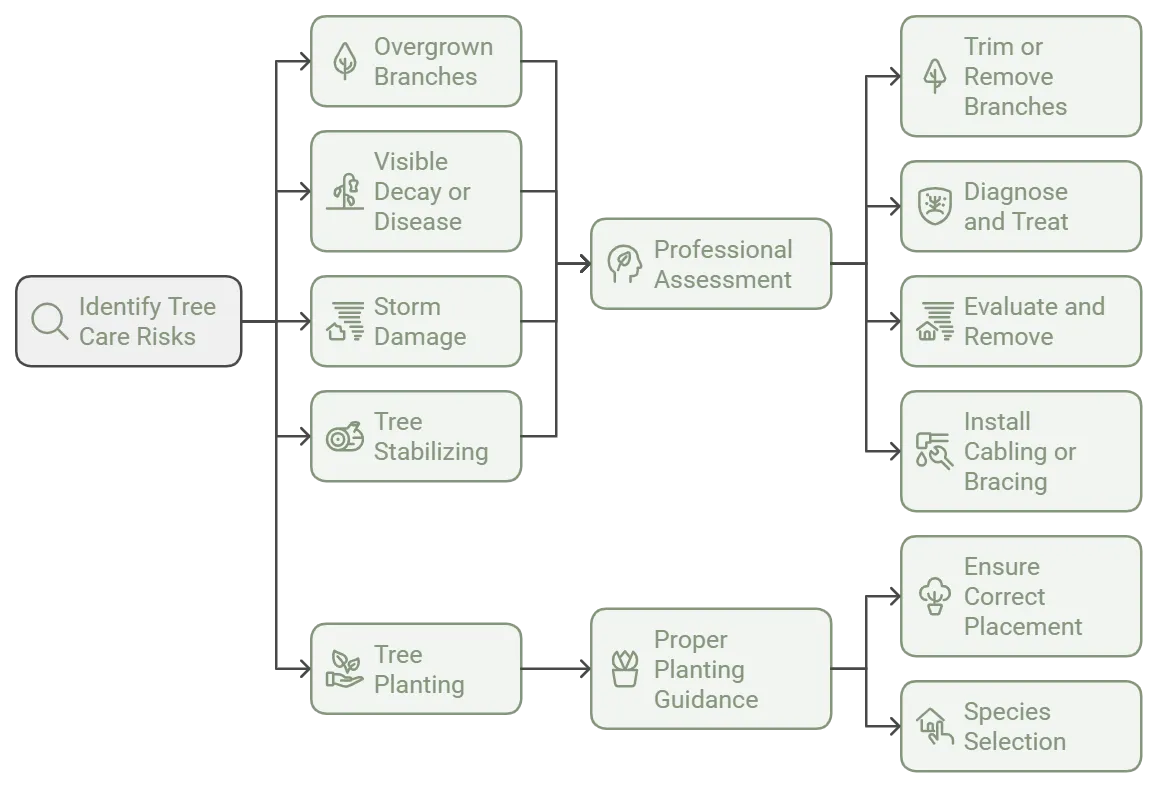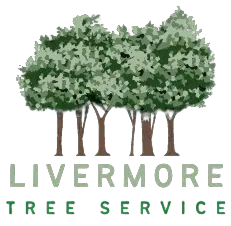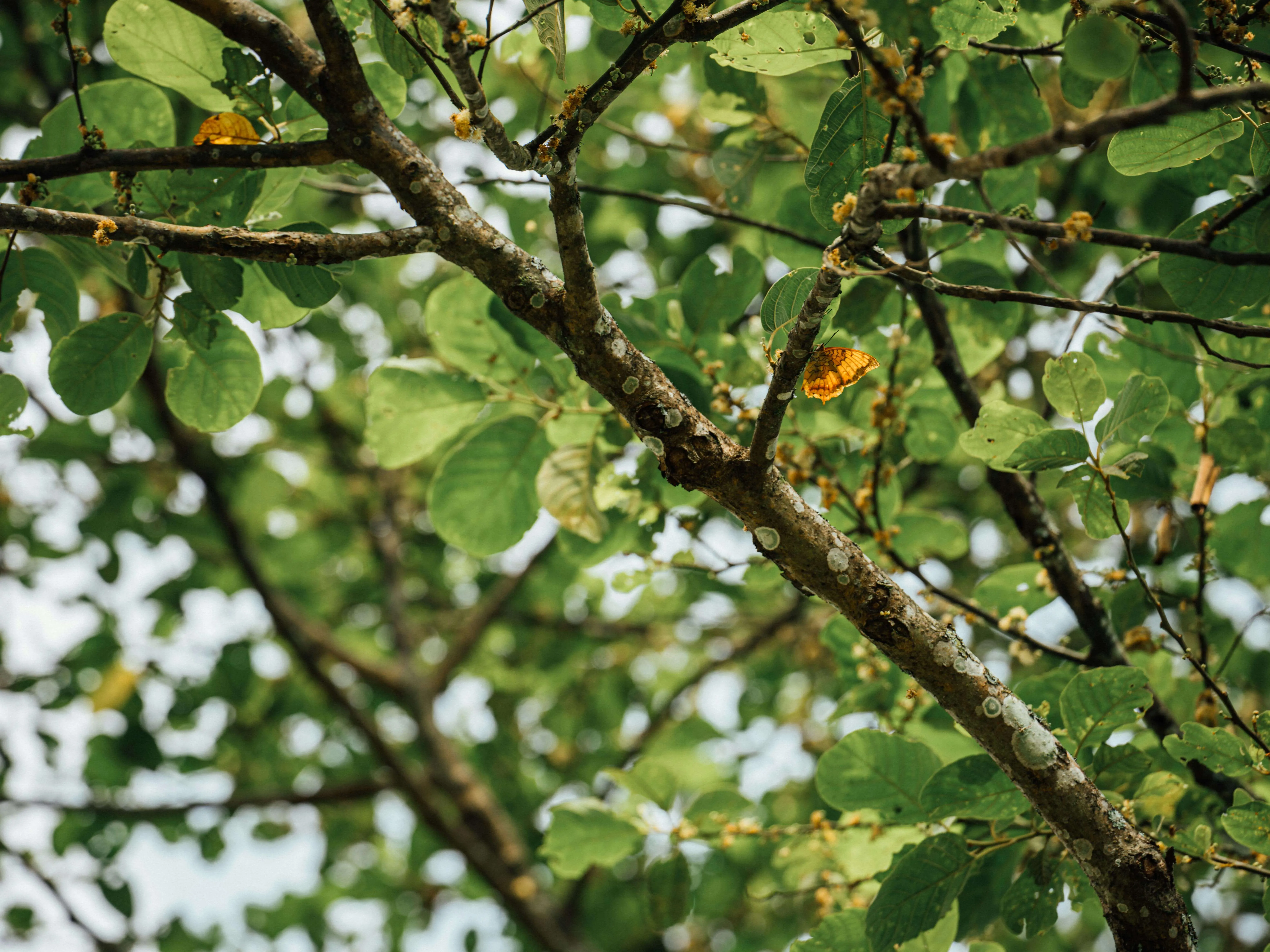Tree Care Tips - Livermore California
Essential Tree Care Tips for Homeowners in Livermore, California
Proper tree care is vital for homeowners in Livermore, California, to maintain the beauty of your landscape and promote tree health and longevity. Trees provide shade, improve air quality, and enhance property values, making them a worthy investment. Here are some essential tips to ensure your trees thrive in this picturesque Californian city.
Understanding Your Trees
Different tree species have unique needs, so identifying the trees on your property is the first step. Common species in Livermore include oak, redwood, and eucalyptus.
Each type requires specific care practices.
- Research your tree types to understand their water needs, sunlight requirements, and growth patterns.
- Consult a local arborist if you're unsure about the species or their care needs.
Watering Techniques
Water is crucial for the health of your trees, especially in Livermore's warm climate. Here are effective watering strategies:
- Deep Watering: Instead of frequent light watering, aim for deep watering sessions once a week. This encourages roots to grow deeper and makes your trees more drought-resistant.
- Watering Schedule: Water your trees early in the morning or late in the evening to reduce evaporation. Young trees need about 10-20 gallons per week, while mature trees may require more.
Mulching Matters
Applying mulch around the base of your trees provides several benefits, including moisture retention and weed suppression. Follow these guidelines:
- Material Choice: Use organic mulch such as wood chips or shredded bark that breaks down over time, enriching the soil.
- Application: Spread a 2-4 inch layer of mulch around the base of the tree, keeping it a few inches away from the trunk to prevent rot.
Pruning Practices
Regular pruning helps maintain the health and aesthetics of your trees. Here’s how to do it right:
- Timing: Prune during the dormant season (late winter to early spring) to minimize stress on the tree.
- Tools: Use sharp, clean tools to make clean cuts. This prevents injury and possible disease entry points.
- Focus Areas: Remove dead, diseased, or crossing branches. Thin out dense areas to allow light and air to reach the inner canopy.
Monitoring Pests and Diseases
Keep an eye out for early signs of pest problems or diseases. Here are some tips:
- Inspect your trees regularly for unusual leaf discoloration, branches that appear wilted, or insect activity.
- Use integrated pest management techniques; consider introducing beneficial insects that prey on harmful pests.
- If significant issues arise, consult a certified arborist for advice on a treatment plan.
Soil Health
Healthy soil equals healthy trees. Here’s how to improve the condition of the soil around your trees:
- Soil Testing: Conduct a soil test to determine pH and nutrient levels. Some local agricultural extensions offer this service.
- Amending Soil: Based on results, add compost or specific fertilizers to improve soil health and boost tree growth.
Seasonal Care Checklist

Engaging in thoughtful tree care can yield long-term benefits for your landscape and increase the value of your property in Livermore, California. With the right practices, your trees will thrive, enhancing your outdoor space for years to come.
Understanding the Climate and Its Impact on Local Tree Species
Understanding the local climate is crucial for anyone caring for or planting trees in Livermore, California. The region experiences a Mediterranean climate characterized by hot, dry summers and mild, wet winters. This climatic pattern significantly influences which tree species thrive and how they should be cared for to ensure their health and longevity.
The hot-dry summer is typically the most defining feature of Livermore's climate. Daytime temperatures can frequently exceed 90°F (32°C), and rainfall is scarce. During these months, it is essential to choose drought-tolerant tree species that can withstand the stress of high temperatures and limited water supply. Trees such as the California Oak and Redbud are excellent choices, as they are native to the region and adapted to the dry conditions.
On the flip side, the mild-wet winters bring precipitation that, while necessary for tree health, also poses risks such as overwatering if proper care isn't taken. During this season, trees like the Coast Live Oak and Willow flourish due to their natural adaptations for wetter soil conditions. These species not only thrive in the winter but also offer essential habitat for local wildlife.
Here's a breakdown of how climate impacts tree species in Livermore

Another significant aspect of the climate is the seasonal wind. Livermore can experience strong winds, particularly in spring and early summer. When selecting trees for this climate, opt for species known for their structural strength. Trees such as the Sugar Pine have a sturdy arrangement and can better withstand windy conditions, minimizing the risk of damage.
Before planting, it's crucial to analyze the specific microclimate of your location in Livermore. Factors such as sun exposure, soil type, and proximity to structures can all influence how well a tree species will establish and grow. For instance, areas that receive full sunlight will favor sun-loving species, while shaded areas might require trees that can adapt to lower light levels.
Proper care practices also cannot be overlooked, especially in the context of Livermore's climate. Trees require a strategic approach to watering, particularly during the scorching summer months. Young trees should receive deep watering once a week, ensuring that their roots penetrate deeply into the soil. Mulching around the tree’s base helps conserve moisture and regulates soil temperature, providing an optimal growing environment.
In addition to watering, regular pruning is essential for maintaining tree health. Pruning during dormancy, typically in late winter, encourages healthy growth patterns and enhances air circulation, which helps prevent fungal diseases prevalent in humid winter conditions.
Keeping an eye on pests and diseases is a critical component of tree care. The mild winters can lead to an increase in pests like aphids and spider mites. Regular inspections and preventive treatments will safeguard your trees from infestations that can compromise their health and vitality.
Understanding the local climate is fundamental for successful tree care in Livermore, California. By selecting appropriate species and adopting an informed care regimen, you'll not only contribute positively to the local ecosystem but also enjoy the aesthetic and environmental benefits that healthy trees provide. When in doubt, consult local tree care professionals who can offer further insights tailored to your specific needs and conditions.
Seasonal Tree Maintenance: What to Do in Each Season
Maintaining trees throughout the changing seasons is essential for their health and longevity. Seasonal tree care involves various tasks that cater to a tree's unique needs at different times of the year. Here’s a breakdown of what to do for tree care during each season.
Spring
Spring is a critical time for tree care as trees wake up from dormancy. As the temperatures warm and rain falls, trees begin to grow and require attention to support their rebirth.
- Pruning: Late winter to early spring is the best time for pruning most species. Remove any dead or damaged branches to encourage new growth. Ensure you use clean, sharp tools to prevent injury to the tree.
- Mulching: Add a layer of organic mulch around the base of your trees. This helps retain moisture, suppress weeds, and provide nutrients as it decomposes.
- Fertilization: Fertilizing your trees promotes healthy growth. Use a slow-release fertilizer designed for trees. Apply it according to package instructions, ensuring it’s suitable for your specific tree species.
Summer
Summer is a time of growth and vigor for trees. Care during this season focuses on hydration and pest management.
- Watering: Deep watering is crucial, especially during dry spells. Ensure your trees receive at least an inch of water per week. Young trees may require more frequent watering to establish strong roots.
- Pest Control: Keep an eye out for pests like aphids or spider mites. Utilize organic pest control methods or hire a professional if infestations occur.
- Monitor for Diseases: Summer heat can stress trees, making them susceptible to diseases. Look for signs of fungal infections or wilting leaves and take action immediately if you notice any issues.
Fall
As the air cools and trees begin to lose their leaves, fall calls for specific tree care practices to prepare for winter.
- Pruning: Late fall or early winter is another ideal time for pruning, especially for trees that flower in spring. Avoid heavy pruning right before winter as it can expose wounds to harsh elements.
- Soil Testing: Fall is an excellent time for soil testing. Understanding your soil’s pH and nutrient levels can help you amend it before the ground freezes.
- Watering: Continue watering until the ground freezes. This ensures trees have enough moisture reserves for the winter season.
Winter
Winter demands a different approach to tree care, focusing on protection and preparation for the upcoming growing season.
- Mulching: Ensure a thick layer of mulch is in place to protect the roots from frost. This insulation helps maintain stable soil temperatures.
- Protecting Trunks: Young trees are particularly at risk from extreme cold and snow load. Wrap the trunks of young trees with burlap or tree wraps to protect against damage.
- Inspection: Inspect branches for potential damage. Remove broken or hanging branches as they can cause further damage during storms or heavy snow.
Year-Round Care
While seasonal care is vital, certain practices should happen throughout the year to maintain tree health.
- Regular Inspections: Consistent inspections for signs of disease or pest issues assist in early detection, which can be key to effective management.
- Tree Health Monitoring: Keeping track of your tree’s overall health, including leaf color and growth patterns, helps identify changes that may require action.
- Consultation with Professionals: Don't hesitate to reach out to arborists for professional assessments, particularly for older trees or those that require specialized care.
By understanding tree care needs in each season, you’ll foster a healthy environment for your trees. Each season brings its unique set of tasks, which, when managed properly, ensure your trees thrive year-round.
Common Tree Pests and Diseases in Livermore and How to Combat Them
Residents of Livermore, California, enjoy a beautiful landscape of diverse trees that enhance the environment. However, maintaining the health of these trees can be a challenge due to various pests and diseases that threaten their vitality. Here's an overview of common tree pests and diseases in the region, along with effective strategies to combat them.
Common Tree Pests
Pests can cause significant damage to trees, compromising their health and longevity. In Livermore, several pests are frequently encountered:
- Western Oak Bark Beetle: This pest targets oak trees, creating small holes in the bark. Infestation can lead to dieback and even tree death if not managed promptly.
- Pine Bark Beetle: Particularly harmful to pine trees, these beetles burrow under the bark, disrupting nutrient flow. Signs of infestation include yellowing needles and pitch tubes.
- Spider Mites: These tiny pests thrive in hot, dry conditions and can cause yellow stippling on leaves. Heavy infestations may lead to premature leaf drop.
- Aphids: These small, soft-bodied insects suck sap from various trees, weakening them and sometimes transmitting plant viruses.
Common Tree Diseases
Diseases can arise from fungal infections, bacterial pathogens, or environmental stressors. In Livermore, the following diseases are particularly prevalent:
- Powdery Mildew: This fungal disease manifests as a white powdery coating on leaves, often leading to stunted growth and leaf drop.
- Root Rot: Caused by fungi in overly wet soil, root rot can lead to tree decline. Signs include yellowing leaves and a general lack of vigor.
- Anthracnose: This fungal disease affects several tree species, causing dark lesions on leaves and stems. If left untreated, it can severely weaken trees.
- Fire Blight: Affecting primarily fruit trees like apples and pears, this bacterial disease causes blossoms and branches to appear scorched.
Combat Strategies
Here are effective strategies to combat these common tree pests and diseases:
Integrated Pest Management (IPM)
Utilizing an Integrated Pest Management approach can effectively control tree pests. Here are the steps involved:
- Monitoring: Regularly check trees for signs of pests or diseases. Early detection is crucial for effective management.
- Identification: Correctly identify the pests or diseases affecting your trees to apply the appropriate control methods.
- Threshold Levels: Determine whether the pest population exceeds acceptable levels before taking action.
- Control Methods: Choose a combination of biological, cultural, physical, and chemical methods to manage the problem effectively.
Cultural Practices
Implementing good cultural practices enhances tree health and resilience:
- Proper Pruning: Regularly prune trees to improve air circulation and reduce humidity, helping to prevent fungal diseases.
- Water Management: Ensure trees receive adequate but not excessive watering to prevent root rot.
- Soil Health: Maintain healthy soil through mulching and organic amendments to promote robust root systems.
Natural and Chemical Controls
For pest control, the following methods can be effective:
- Beneficial Insects: Encourage or introduce natural predators like ladybugs or lacewings to control aphid and mite populations.
- Neem Oil: This natural pesticide is effective against many tree pests and can help manage diseases like powdery mildew.
- Fungicides: Use fungicides to treat fungal infections as needed. Be sure to follow the product’s instructions closely.
By staying informed about common tree pests and diseases in Livermore and applying the right management strategies, residents can help ensure the health and beauty of their trees. Vigilant care and timely action are key to keeping trees thriving in this vibrant California landscape.
The Importance of Professional Tree Services: When to Seek Help
When it comes to maintaining the health and aesthetics of your property, trees are vital assets. However, managing tree care can be complex, and knowing when to enlist professional tree services is crucial for both safety and health. Various factors play a role in determining when it’s time to seek help from experts.
First and foremost, consider the size and type of your trees. Large trees can pose safety risks when maintenance is needed, particularly if they are close to power lines or structures. If you notice branches extending too close to electrical wires or rooftops, it’s wise to call in professionals. Trained arborists have the skills and equipment necessary to handle such tasks safely.
If you’re in Livermore, California, the dry climate can lead to unique situations that may require expert assistance. For instance, seasonal changes can introduce pests or diseases that affect tree vitality. Watch for signs of distress, such as wilted leaves, unusual growths, or discoloration. If your trees seem unhealthy but you’re unsure why, reach out to tree care specialists who can diagnose the issue and recommend appropriate action.
Another crucial scenario where professional help is beneficial is storm damage. After severe weather events, inspect your trees carefully. If branches are split or the tree seems unstable, do not attempt to remove them yourself. Professionals are equipped to handle these dangers safely and will know how to assess whether the tree can be saved or needs to be removed entirely.
Consider the following situations that warrant calling in professionals:
Situation - 
Beyond immediate safety concerns, professionals also bring knowledge to the table regarding optimal care for your tree’s health. They understand nuanced factors like soil quality, environmental stressors, and seasonal cycles that contribute to a tree’s overall well-being. By engaging their services, you not only protect your landscape but also enhance its value over time.
When seeking tree service providers, focus on finding certified arborists. Their expertise can dramatically improve the outcomes of your tree care efforts. Certification indicates a commitment to ongoing education and adherence to industry standards, ensuring you receive the best care possible.
The frequency of tree maintenance is another critical aspect. Regular inspections by professionals can spot problems before they escalate into costly issues. Experts can advise you on an appropriate pruning schedule, usually recommended every 3-5 years, depending on the species and growth patterns of your trees.
Moreover, professional tree services also offer emergency assistance. If you encounter a hazardous situation requiring immediate attention, knowing whom to call can save time and prevent potential accidents. Trees can fall in unexpected ways, and having a reliable service on speed dial can ease your worries during crises.
In addition to emergency services, gather information on tree health assessments and disease management from reputable tree care companies. They can provide insights into local pests and pathogens affecting trees in Livermore, ensuring you're proactive in care and management.
Maintaining the health and safety of your trees requires ongoing attention and sometimes professional intervention. By recognizing situations where expert assistance is crucial, you can keep your property safe and lush while enhancing the appeal of your landscape. Don’t hesitate to reach out to dedicated professionals for advice and service. Investing in tree care today promises a sustainable and beautiful environment for the future.
Key Takeaway:
Maintaining healthy trees is crucial for homeowners in Livermore, California, and understanding the unique aspects of tree care in this region can significantly enhance both garden aesthetic and environmental health.
Here are the key takeaways based on essential topics covered regarding tree care. Firstly, effective tree care starts with recognizing which tree species thrive in Livermore's climate—characterized by hot, dry summers and mild winters.
Homeowners should select native or well-adapted species that will not only survive but flourish in these conditions. Familiarity with these local tree species enables homeowners to provide the proper care they require, ensuring strong growth and resilience.
Seasonal maintenance is vital for optimal tree health. Each season presents unique needs; for instance, pruning during winter helps remove dead or diseased branches while preparing trees for spring growth.
In contrast, summer might focus on monitoring water needs and pest management, and fall is an excellent time for mulching and ensuring nutrient health before winter dormancy. Recognizing the cyclical nature of tree care ensures that homeowners do not overlook any critical maintenance tasks throughout the year.
Moreover, Livermore's trees face specific threats from pests and diseases, including pests like aphids and diseases such as root rot. Being aware of these common issues allows homeowners to take preventive measures and address problems early.
Integrated pest management is a strategy that combines biological, cultural, and chemical practices aimed at treating and preventing infestations, making it a crucial topic for local tree care discussions.
The importance of professional tree services cannot be overstated. While many aspects of tree care can be managed by homeowners, certain tasks—especially those involving significant tree risk, such as large tree removals or treating extensive diseases—should be left to professionals. Seeking expert help not only provides peace of mind but ensures that the job is done efficiently and safely.
Tree care in Livermore requires a combination of knowledge about local species, seasonal practices, pest management, and recognizing when to call in the experts. This proactive approach fosters a thriving landscape and contributes to the community’s ecological health.
Conclusion
Taking care of trees in Livermore, California, isn’t just an aesthetic pursuit; it’s an essential part of maintaining a healthy and sustainable environment. With the tips outlined throughout this article, you can confidently protect and nurture the trees you cherish on your property. A clear understanding of each aspect, from seasonal maintenance to identifying pests, contributes to the longevity and vitality of your trees.
By recognizing the essential tree care tips for homeowners, you can establish a solid foundation for your tree care routine. Regular inspections and maintenance activities such as pruning, mulching, and watering will go a long way in ensuring your trees thrive. Remember, proactive care is always better than reactive measures. Regularly assessing the condition of your trees helps you catch problems early on, potentially saving you the cost of extensive damage repair.
Understanding the unique climate of Livermore is crucial when determining which tree species will best flourish in your landscape. The Mediterranean climate presents both advantages and challenges for local flora. Native species are better adapted to withstand heat and drought, offering resilience against the elements. Educating yourself about local tree species not only contributes to a more diverse ecosystem but also provides you with trees that require less intensive care, saving you time and resources in the long run.
As the seasons change, so too should your tree care approach. Seasonal maintenance tasks, such as deep watering during the dry summer months and protective mulching in winter, are imperative for your trees’ health. Springtime is ideal for pruning to promote healthy growth, while fall can be the time for giving trees a nourishing fertilizer to prepare them for dormancy. Establishing a seasonal checklist for tree care will allow you to stay organized and ensure you’re attending to your trees’ needs at the right time.
Encountering pests and diseases is an unfortunate reality of tree care. In Livermore, common pests like aphids and spider mites can wreak havoc on your trees if not managed efficiently. Learning how to identify early signs of infestation or disease will arm you with the knowledge needed to intervene quickly. Home remedies, natural deterrents, or targeted applications will often do the trick, but it’s essential to monitor the situation closely for re-infestation. Combating common tree pests effectively not only protects your trees but also contributes to the broader ecosystem's health.
Despite your best efforts, there may come a time when tree care becomes overwhelming or requires specialized knowledge and equipment. This is when professional tree services become invaluable. Whether you need a tree removed due to safety concerns or need expert advice on treatment for a pest problem, don't hesitate to reach out for help. Certified arborists bring expertise that ensures not only the health of your trees but also your safety. They can employ advanced techniques and tools to carry out tasks that may pose a risk if managed solo. Knowing when to seek professional assistance is a testament to responsible tree stewardship.
Each of these facets—from essential tree care practices to the climatic understanding of Livermore and the need for professional help—adds layers of depth to your knowledge base. Your trees are not just elements of your landscape; they provide ecological benefits, enhance property value, and contribute to your home's ambiance.
Investing time in tree care will yield significant returns, both visually and environmentally. Keep in mind that patience and diligence are key. With the right approach, you can create an inviting space filled with healthy, thriving trees that blossom with beauty for many years to come.
As you cultivate your landscape, remember that tree care is a continuous journey. By applying the tips and strategies discussed, you will not only enhance your backyard but help maintain Livermore's ecological balance. So roll up your sleeves and get started—your trees will thank you!


